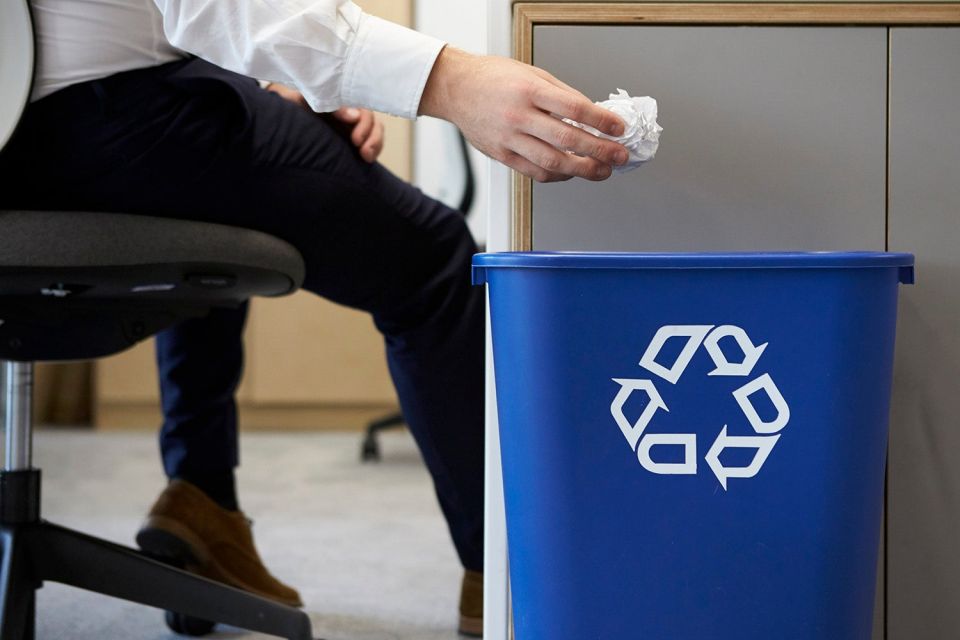In his address to the Academic Council last spring, President Marc Tessier-Lavigne announced Stanford’s goal to become a zero-waste campus by 2030. The announcement came just months after the biggest shakeup in the global recycling industry in recent memory, which threatened years of sustainability progress on campus. But thanks to good recycling habits, infrastructure enhancements and development of a sound strategy to reach zero waste, the university is weathering the storm and remains on track to hit its goal.

Julie Muir is the manager for Peninsula Sanitary Service/Stanford Recycling. (Image credit: L.A. Cicero)
Over the past few decades, Stanford has made enormous gains in minimizing campus waste. Major initiatives like recycling, composting, waste minimization training, and the My Cardinal Green engagement program have helped the university dramatically reduce the amount of material it sends to landfills. In 2017, only 8,190 tons of waste went to landfills (a 63 percent diversion rate), down from 14,000 tons in 1998.
Riding this wave of momentum, it seemed nothing could stand in the way of Stanford’s progress – until last year. That’s when the world’s second-largest economy and No. 1 importer of foreign waste sent shockwaves through the global waste and recycling industry.
Last summer, officials in China notified the World Trade Organization that the country would ban the import of 24 types of recyclable waste products, citing health and environmental concerns. The ban took effect at the start of this year.
“When Jan. 1 came, there was a scramble in the U.S. to find places to send waste,” said Julie Muir, manager at Peninsula Sanitary Service/Stanford Recycling (PSSI).
Other international waste markets – including those in Vietnam and Indonesia – were suddenly inundated with new business, but quickly became overwhelmed and were forced to turn away customers and brokers wanting to sell materials. The result has left many countries and municipalities no choice but to hoard their recycling products.

Stanford practices what is known as dual-stream recycling, which means paper and cardboard products are disposed of in separate containers from plastic, glass and metal. (Image credit: Getty Images)
“In the midst of [the ban], it was scary because you didn’t know what it was going to bring,” Muir said. “In our case, we were able to move.”
For years, Stanford has sent its recyclable paper to a mill in San Jose. But when the ban went into effect, the company said paper wasn’t profitable since it could no longer be sold to China or another buyer. Muir said the university’s temporary solution was to go to a company in San Leandro, whose broker had found a market in India that would purchase recyclable paper.
After only having to divert a couple of loads to San Leandro, Muir said, PSSI was able to continue business with the San Jose company. “Not to say it wasn’t uncomfortable,” she said. “But we weren’t thrown into disarray.”
Muir said the backup plan was successful in part because the university has maintained good relationships within the industry. But she also credited the university’s good waste and recycling habits as a reason Stanford was able to ride out the ban.
Stanford has always practiced what is known as dual-stream recycling, which means paper and cardboard products are disposed of in separate containers from plastic, metal and glass. The result is cleaner paper products that would otherwise be contaminated if mixed with those items, as is what happens in a single-stream system, which was practiced by most of the country before the ban, including the cities of Palo Alto and San Francisco.
“Our message is to keep recycling, but to make sure you’re recycling the right things.”
—Julie Muir
Manager, PSSI
Eight months after China’s ban was implemented, Stanford remains largely unscathed by the effects of the policy. Despite this, Muir said the campus community should view the ban as a call to action.
“Our message is to keep recycling, but to make sure you’re recycling the right things,” Muir said. Keeping bottles and cans out of containers for paper, as well as utilizing composting bins, will dramatically reduce contamination. Small measures like two-sided printing and adjusting margins to reduce printing will cut down on the amount of paper that is used. Additionally, buying recycled content with every purchase will lead companies to use more recycled materials.
The university is working on the strategy for achieving the zero-waste goal, which is a 90 percent diversion or higher, said Fahmida Ahmed, director of Sustainability and Business Services in the Department of Sustainability and Energy Management.
The process also includes incorporating more sustainable products and choices in the items the university buys, she said. “The smarter, greener purchases we make, the less need we have for landfill down the road. Stanford’s goal of achieving zero waste by 2030 offers the opportunity to make significant progress in multiple frontiers.”
Until then, the Office of Sustainability and its partners offer a number of resources for the campus community. Among them are sustainable purchasing guidelines, waste minimization training and engagement opportunities like the Sustainability Game Day Challenge and RecycleMania.
For more information about Stanford’s waste and recycling measures, visit the Peninsula Sanitary Service/Stanford Recycling webpage.